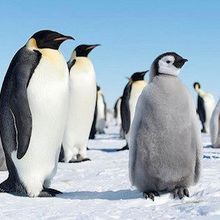Login
SubscribeImage of the Day

Image of the Day: Social Drinking
The Scientist | Apr 27, 2017 | 1 min read
Drunken crayfish will roll on their backs and enthusiastically perform tail flips in their tanks. The animals are more likely to display they behaviors after spending time in a social environment compared with an isolated one.

Image of the Day: Colorful Crystals
The Scientist | Apr 26, 2017 | 1 min read
Thecla opisena butterfly wings get their unique luster from the crystalline structures in their scales (bottom right).

Image of the Day: Placental Array
The Scientist | Apr 25, 2017 | 1 min read
Placentas from mice with genetically distinct immune systems, stained to highlight differences in three proteins, representing the nucleus (blue), blood vessels (red), and trophoblasts (green)

Image of the Day: World Penguin Day
The Scientist | Apr 24, 2017 | 1 min read
Emperor penguins are among the largest birds in the world. Approximately 595,000 of them live in Antarctica.

Image of the Day: Science March Scenes
The Scientist | Apr 23, 2017 | 1 min read
On April 22, thousands of people took to the streets to take part in Marches for Science around the world.

Image of the Day: Fungal Forms
The Scientist | Apr 19, 2017 | 1 min read
By sequencing and analyzing the genomes of more than 20 species of Penicillium fungi, researches uncovered genes encoding for numerous bioactive compounds, including antibiotics.

Image of the Day: Giant Shipworm
The Scientist | Apr 18, 2017 | 1 min read
Kuphus polythalamia is a worm-like mollusk that can reach up to 155 cm in length, is encased in a hard, tusk-like shell, and lives in sulfur-rich mud.

Image of the Day: Night Crawler
The Scientist | Apr 17, 2017 | 1 min read
Phyllomedusa bicolor is a nocturnal, tree-dwelling frog that lives in the Amazon rainforest.

Image of the Day: Stop Signals
The Scientist | Apr 16, 2017 | 1 min read
Transcytosis, suppression of vesicle traffic across cells, helps reduce permeability in the blood-retinal barrier during development.

Image of the Day: Fanged Fish
The Scientist | Apr 13, 2017 | 1 min read
Poisonous fang blennies (Meiacanthus) are only around 2 inches long but, with their tiny fangs, they can inject predators with a venom that has potent hypotensive effects.

Image of the Day: Inner Conflicts
The Scientist | Apr 12, 2017 | 1 min read
Transcriptomic analyses of a patient with severe Ebola virus disease revealed shifts in the expression of antiviral and immune response genes, corresponding to the stages of illness.

Image of the Day: Sonic Snapper
The Scientist | Apr 11, 2017 | 1 min read
By rapidly snapping its large claw shut, the newly discovered pistol shrimp, Synalpheus pinkfloydi, can create enough sonic energy to stun—even kill—small fish.

Image of the Day: Bygone Blood Cells
The Scientist | Apr 10, 2017 | 1 min read
These fossilized red blood cells (right), found in an ancient, blood-engorged Amblyomma tick (left), likely belonged to primates.

Image of the Day: Ancient Worm
The Scientist | Apr 9, 2017 | 1 min read
Unlike related species, Ovatiovermis cribratus, a lobopodian from the Cambrian period, did not have a hard, protective shell.

Image of the Day: Long-Distance Messaging
The Scientist | Apr 6, 2017 | 1 min read
After an inflammatory injury occurs in the brain, astrocytes release extracellular vesicles that travel to the liver and trigger an immune response.

Image of the Day: Fighting Filoviruses
The Scientist | Apr 5, 2017 | 1 min read
Researches develop a human monoclonal antibody against two filoviruses, Marburg and Ravn, which, like Ebola, can cause hemorrhagic fever.

Image of the Day: Works In Progress
The Scientist | Apr 4, 2017 | 1 min read
An NIH survey of 351 individuals in the research community has shown that many are supportive of interim research products like preprints.

Image of the Day: Sharp Shooters
The Scientist | Apr 3, 2017 | 1 min read
Single-celled dinoflagellates (Polykrikos) use harpoon-like organelles to hunt and capture prey.

Image of the Day: Tail Eyes
The Scientist | Apr 2, 2017 | 1 min read
Following treatment with a migraine drug, blind tadpoles were able to process visual information through eyes transplanted onto their tails.

Image of the Day: Personnel Effects
The Scientist | Mar 30, 2017 | 1 min read
Cuts to federal science funding could significantly impact undergraduate students, graduate students, postdocs, and other early-career researchers.